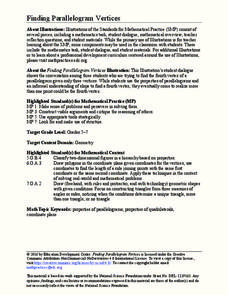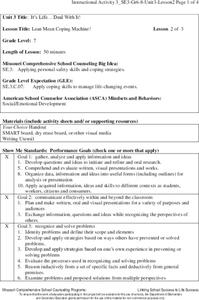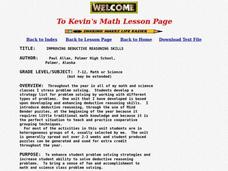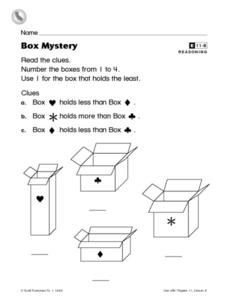Curated OER
Proofs Of The Pythagorean Theorem?
Even U.S. President James Garfield had his own proof of the Pythagorean Theorem! Pupils consider three different attempts at a geometric proof of the Pythagorean Theorem. They then select the best proof and write paragraphs detailing...
Inside Mathematics
Graphs (2006)
When told to describe a line, do your pupils list its color, length, and which side is high or low? Use a worksheet that engages scholars to properly label line graphs. It then requests two applied reasoning answers.
EngageNY
Proofs of Laws of Exponents
Apply pupil understanding of exponent properties to prove the relationships. In the sixth lesson of the series, individuals are expected to prove relationships using mathematical statements and reasoning.
Noyce Foundation
The Wheel Shop
Teach solving for unknowns through a problem-solving approach. The grouping of five lessons progresses from finding an unknown through simple reasoning to solving simultaneous equations involving three and four variables. Each lesson...
EngageNY
Drawing the Coordinate Plane and Points on the Plane
To plot a point in the coordinate plane, you first need a coordinate plane. Pupils learn to draw an appropriate set of axes with labels on a coordinate plane. They must also determine a reasonable scale to plot given coordinate pairs on...
Education Development Center
Finding Parallelogram Vertices
Four is the perfect number—if you're talking about parallelograms. Scholars determine a possible fourth vertex of a parallelogram in the coordinate plane given the coordinates of three vertices. They read a conversation...
Prestwick House
Analyzing Multiple Interpretations of Literature
There is a reason why an Oscar is given each year for the Best Adaptation Screenplay. Adaptations are the focus of an exercise that asks class members to compare a work of literature with a least one adaptation of the work into a...
British Council
Unit 7: Organising Your Writing
Get energized by being organized! Budding business scholars construct professional letters in the seventh of nine career education and skills lessons. The resource covers proper greetings, writing requests, and explaining reasons for...
State Bar of Texas
Wisconsin v. Yoder
How far does freedom of religion truly go? The 1972 Supreme Court case Wisconsin v. Yoder introduces the concept of the free exercise clause of the First Amendment. Individuals examine the case with a short video and open discussion. To...
Jamestown-Yorktown Foundation
Why Did Some Colonial Virginians Seek Independence?
To understand the reasonings of those colonials who sought independence from England, young historians are divided into content groups that examine documents related to either the Boston Tea Party, the Yorktown Tea Party, Tea Overboard,...
Florida Center for Reading Research
Comprehension: Text Analysis, Fiction and Nonfiction Find
Scholars analyze fiction and nonfiction text and fill in a worksheet detailing the text's title, genre, and reason for its classification.
Missouri Department of Elementary
Lean Mean Coping Machine!
Seventh graders are asked to choose and rank five scenarios from a list of ten that are most important to them. After explaining the reasons for the choices, they then identify the coping skills they used to make their decisions.
C-SPAN
Political Polarization
Dive into the political breach with pupils and explore the reasons for political polarization. Using clips from C-SPAN that include discussions from reporters and scholars, class members consider what is causing the political fault lines...
Curated OER
Bead It!
Fourth graders use colored beads in two problems and explore the use of proportional reasoning as a problem solving method. Working Students, in groups, explain their reasoning strategies orally, and through drawings.
Curated OER
Improving Deductive Reasoning Skills
Students recognize problems that may be solved using deductive reasoning, and develop aids to help them in solving these problems. They produce their own deductive reasoning puzzles for other students to solve.
Curated OER
Everything You Know Is Wrong 1: Us and Them
High schoolers explore rational, irrational, analytical and non-analytical methods of reasoning. They participate in numerous exercises and hands-on activities to understand assumptions and how most people think. Students establish the...
Curated OER
Adaptations in bird's beaks
In this bird's beaks learning exercise, students explore the reasons for adaptations in the beaks of the birds pictured. Students complete 4 problems.
Curated OER
Arithmetic Chains
Students complete a chain of numbers given the outcome. In this geometry lesson, student use deductive and inductive reasoning to solve problems. They create a formula and ways to predict numbers in the chain without starting over.
Curated OER
Critical Thinking - Week 11
In this critical thinking worksheet, students complete problems which require abstract reasoning and logic. They complete logic puzzles involving sums of an array, finding the maximum number of integers under given conditions, and card...
Curated OER
Shopping Spree- How Many Outfits Can You Make?
In this shopping spree, reasoning worksheet, 3rd graders list the outfits that can be made from 4 pairs of jeans and 4 t-shirts. They examine their list for patterns, and extend the reasoning to different numbers of pants and shirts.
Curated OER
Box Mystery
In this math reasoning learning exercise, students read 4 clues that describe the capacity of 4 boxes. Students use reasoning to number the boxes from 1 to 4 as the clues are analyzed.
Curated OER
Let's Line Up!
In this reasoning instructional activity, 2nd graders use logical reasoning to determine what each person's place in line is. Students are given 4 questions to practice the skill.
Curated OER
Problem Solving: Find an Average
In this finding the average word problem worksheet, students problem solve and explain why the average is reasonable or not reasonable. Students solve six problems.
Curated OER
Abstinence
Students identify positive reasons why people choose to practice abstinence and complete communication that is successful in this practice. In this abstinence lesson plan, students view videos and fill out worksheets provided.
Other popular searches
- Deductive Reasoning Puzzles
- Deductive Reasoning
- Inductive Reasoning
- Logical Reasoning
- Proportional Reasoning
- Reason for the Seasons
- Mathematical Reasoning
- Deductive Reasoning Math
- Thinking and Reasoning
- Thinking & Reasoning
- Inferential Reasoning
- Proportional Relationships

























